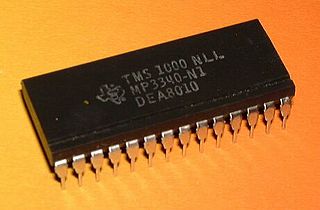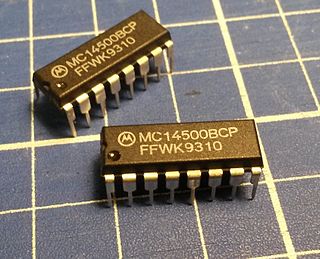
The MC14500B Industrial Control Unit (ICU) is a CMOS one-bit microprocessor designed by Motorola for simple control applications in 1977. [1]

The MC14500B Industrial Control Unit (ICU) is a CMOS one-bit microprocessor designed by Motorola for simple control applications in 1977. [1]
MC14500B (ICU) is well-suited to the implementation of ladder logic, and thus could be used to replace relay systems and programmable logic controllers, also intended for serial data manipulation. [2] The processor supports 16 commands, operating at a frequency of 1 MHz. [2] The MC14500B unit does not include a program counter (PC); instead, a clock signal drives a separate PC chip; therefore the size of supported memory is dependent on the implementation of that chip. It was still in production in 1995. [2]
The ICU architecture is similar to that of the DEC PDP-14 computer.[ citation needed ][ clarification needed ]
The ICU was conceived by Vern Gregory in the mid-1970s while working as an engineer in a marketing / applications group of Motorola Semiconductor Products Sector in Phoenix, Arizona, USA; Brian Dellande originated circuit and sub-routine designs, and co-wrote the manual; Ray DiSilvestro was the bench technician; Terry Malarkey provided management support.[ citation needed ]
In the CMOS Logic Division in Austin, Texas, USA (where it was made) Phil Smith was the chip designer; Mike Hadley provided product applications support.[ citation needed ]
A form of the design served as an embedded controller in a custom automotive chip made for Nippon Denso by Motorola—Japan.
I.P.R.S. Băneasa manufactured a clone of the MC14500B with the designation βP14500 in IIL technology (rather than the original CMOS). [3]
One of the computers known to be based on this processor is the educational WDR 1-bit computer (512 bits of RAM, LED, I/O, keyboard). [4]
A modern take, in retro style, of a computer based on this processor is the PLC14500-Nano. It is certified as Open Source Hardware PL000011 so anyone can learn from its design and can freely build it.

An integrated circuit (IC), also known as a microchip, computer chip, or simply chip, is a small electronic device made up of multiple interconnected electronic components such as transistors, resistors, and capacitors. These components are etched onto a small piece of semiconductor material, usually silicon. Integrated circuits are used in a wide range of electronic devices, including computers, smartphones, and televisions, to perform various functions such as processing and storing information. They have greatly impacted the field of electronics by enabling device miniaturization and enhanced functionality.

A microprocessor is a computer processor for which the data processing logic and control is included on a single integrated circuit (IC), or a small number of ICs. The microprocessor contains the arithmetic, logic, and control circuitry required to perform the functions of a computer's central processing unit (CPU). The IC is capable of interpreting and executing program instructions and performing arithmetic operations. The microprocessor is a multipurpose, clock-driven, register-based, digital integrated circuit that accepts binary data as input, processes it according to instructions stored in its memory, and provides results as output. Microprocessors contain both combinational logic and sequential digital logic, and operate on numbers and symbols represented in the binary number system.

The Motorola 68000 is a 16/32-bit complex instruction set computer (CISC) microprocessor, introduced in 1979 by Motorola Semiconductor Products Sector.

The MOS Technology 6502 is an 8-bit microprocessor that was designed by a small team led by Chuck Peddle for MOS Technology. The design team had formerly worked at Motorola on the Motorola 6800 project; the 6502 is essentially a simplified, less expensive and faster version of that design.

The 6800 is an 8-bit microprocessor designed and first manufactured by Motorola in 1974. The MC6800 microprocessor was part of the M6800 Microcomputer System that also included serial and parallel interface ICs, RAM, ROM and other support chips. A significant design feature was that the M6800 family of ICs required only a single five-volt power supply at a time when most other microprocessors required three voltages. The M6800 Microcomputer System was announced in March 1974 and was in full production by the end of that year.

MOS Technology, Inc. ("MOS" being short for Metal Oxide Semiconductor), later known as CSG (Commodore Semiconductor Group) and GMT Microelectronics, was a semiconductor design and fabrication company based in Audubon, Pennsylvania. It is most famous for its 6502 microprocessor and various designs for Commodore International's range of home computers.

Semiconductor device fabrication is the process used to manufacture semiconductor devices, typically integrated circuits (ICs) such as computer processors, microcontrollers, and memory chips. It is a multiple-step photolithographic and physico-chemical process during which electronic circuits are gradually created on a wafer, typically made of pure single-crystal semiconducting material. Silicon is almost always used, but various compound semiconductors are used for specialized applications.

The 7400 series is a popular logic family of transistor–transistor logic (TTL) integrated circuits (ICs).

Freescale Semiconductor, Inc. was an American semiconductor manufacturer. It was created by the divestiture of the Semiconductor Products Sector of Motorola in 2004. Freescale focused their integrated circuit products on the automotive, embedded and communications markets. It was bought by a private investor group in 2006, and subsequently merged with NXP Semiconductors in 2015.

Mostek Corporation was a semiconductor integrated circuit manufacturer, founded in 1969 by L. J. Sevin, Louay E. Sharif, Richard L. Petritz and other ex-employees of Texas Instruments. At its peak in the late 1970s, Mostek held an 85% market share of the dynamic random-access memory (DRAM) memory chip market worldwide, until being eclipsed by lower-priced Japanese DRAM manufacturers who were accused of dumping memory on the market.
Bit slicing is a technique for constructing a processor from modules of processors of smaller bit width, for the purpose of increasing the word length; in theory to make an arbitrary n-bit central processing unit (CPU). Each of these component modules processes one bit field or "slice" of an operand. The grouped processing components would then have the capability to process the chosen full word-length of a given software design.
The transistor count is the number of transistors in an electronic device. It is the most common measure of integrated circuit complexity. The rate at which MOS transistor counts have increased generally follows Moore's law, which observes that transistor count doubles approximately every two years. However, being directly proportional to the area of a die, transistor count does not represent how advanced the corresponding manufacturing technology is. A better indication of this is transistor density which is the ratio of a semiconductor's transistor count to its die area.
The PowerPC 600 family was the first family of PowerPC processors built. They were designed at the Somerset facility in Austin, Texas, jointly funded and staffed by engineers from IBM and Motorola as a part of the AIM alliance. Somerset was opened in 1992 and its goal was to make the first PowerPC processor and then keep designing general purpose PowerPC processors for personal computers. The first incarnation became the PowerPC 601 in 1993, and the second generation soon followed with the PowerPC 603, PowerPC 604 and the 64-bit PowerPC 620.
The 3 μm process is the level of MOSFET semiconductor process technology that was reached around 1977, by companies such as Intel.
The R2000 is a 32-bit microprocessor chip set developed by MIPS Computer Systems that implemented the MIPS I instruction set architecture (ISA). Introduced in January 1986, it was, by a few months, the first commercial implementation of the RISC architecture. The R2000 competed with Digital Equipment Corporation (DEC) VAX minicomputers and with Motorola 68000 and Intel Corporation 80386 microprocessors. R2000 users included Ardent Computer, DEC, Silicon Graphics, Northern Telecom and MIPS's own Unix workstations.
In computer architecture, 16-bit integers, memory addresses, or other data units are those that are 16 bits wide. Also, 16-bit central processing unit (CPU) and arithmetic logic unit (ALU) architectures are those that are based on registers, address buses, or data buses of that size. 16-bit microcomputers are microcomputers that use 16-bit microprocessors.

In computer architecture, 1-bit integers or other data units are those that are 1 bit wide. Also, 1-bit central processing unit (CPU) and arithmetic logic unit (ALU) architectures are those that are based on registers of that size.
The electronics industry in the Socialist Republic of Romania was characterized by stronger ties to Western Europe when compared to other countries in the Eastern Bloc due to the drive of the Romanian leadership towards greater autonomy from the Soviet Union.
{{cite book}}: |work= ignored (help)